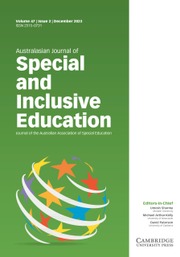Article contents
Exploring Bhutanese Teachers’ Perceptions of Differentiated Instruction in Inclusive Schools in Bhutan
Published online by Cambridge University Press: 28 April 2022
Abstract
Differentiated instruction (DI) is an inclusive teaching approach that recognises and values student differences. Teachers teaching in inclusive schools practise DI to accommodate students with special educational needs and disabilities. However, no research has yet been conducted to explore teachers’ perceptions of DI in Bhutan. The purpose of this quantitative study is to explore teachers’ perceptions of DI and the differences in their perceptions based on demographic variables. Data were collected via an online survey from 185 teachers in 19 inclusive schools and were analysed using descriptive and inferential statistics. The results indicated that the majority of teachers had favourable perceptions of DI. No significant perceptual differences were found on qualifications and teaching experiences. However, special education teachers’ perceptions of DI were significantly higher than general education teachers (M = 4.14, SD = .37), (M = 3.89, SD = .41), respectively, t(183) = 4.194, p = .000, and trained teachers’ perceptions of DI were also found to be significantly higher than untrained teachers (M = 4.09, SD = .39), (M = 3.81, SD = .40), respectively, t(183) = 4.090, p = .000. The implications of the research findings are discussed with recommendations for further research in this area.
Keywords
Information
- Type
- Original Articles
- Information
- Australasian Journal of Special and Inclusive Education , Volume 46 , Issue 1 , July 2022 , pp. 88 - 100
- Copyright
- © The Author(s), 2022. Published by Cambridge University Press
Footnotes
This manuscript was accepted under the Editorship of Michael Arthur-Kelly.
References
- 1
- Cited by

